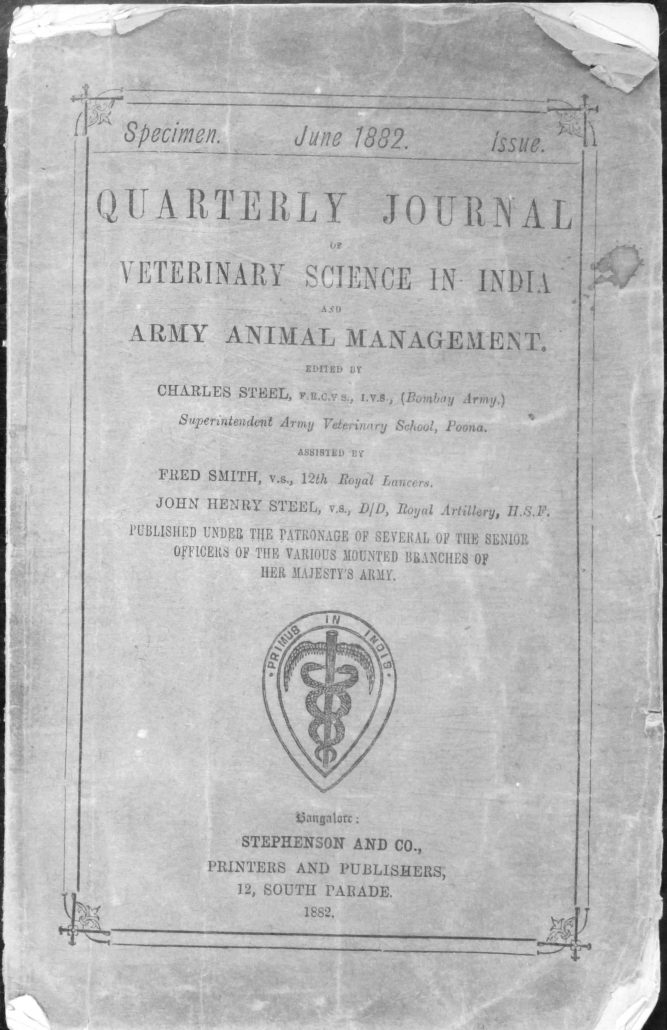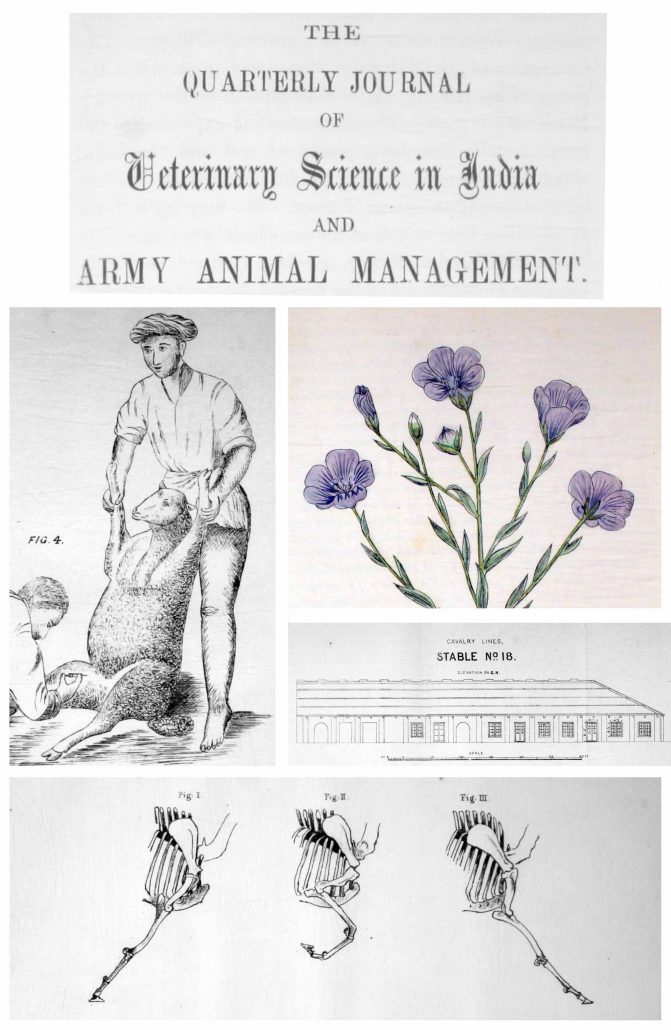17 – Letter to Fred Bullock from Frederick Smith, 19 Mar 1922
The copyright of this material belongs to the Royal College of Veterinary Surgeons. It is available for reuse under a Creative Commons, Attribution, Non-commercial license.
Help more people find this work! Suggest a tag via the form:
Recently there has been another of those coincidences that those of us who work in libraries love. Two quite separate enquiries which end up having something – or in this case someone – in common.
The first enquiry was from a researcher who wanted to look at The quarterly journal of veterinary science in India and army animal management and the second from someone who was researching James McCall, founder of Glasgow Veterinary College.
The connection? John Henry Steel – who was the co-founder of the journal and who had a medal named after him which was awarded to McCall in 1899.
As is usual when this happens curiosity got the better of me and I had to find out more..
John Henry Steel FRCVS (1855-1891) followed his father into the veterinary profession, graduating from the London Veterinary College in 1875. After a brief spell in the army he took up a post as Demonstrator of Anatomy at the London College where he remained for five years, before resigning when the professorship, which he had been promised, was abolished.
He re-entered the army and, in 1882, went to serve in India, which was to be the scene of his most notable achievements. Upon arrival, he “was immediately impressed by the utter want, outside the Army, of anything approaching Veterinary Science” and set about rectifying the situation.
One of his first moves was to establish, in 1883, The quarterly journal of veterinary science in India and army animal management. This journal, which he co-founded with Frederick Smith, allowed vets to share information and record progress in treatments etc.
Secondly, in 1886, he established a veterinary college in Bombay so that the population could be “educated in veterinary matters”.
Sadly the severe mental and physical strain of running the journal and the College took its toll and he was taken ill, returning to England in 1888. Against the advice of doctors, he went back to India after a few months and involved himself fully in the life of Bombay, taking up the reins at the College again and becoming a Fellow of the University and a JP.
His health did not improve and, seemingly aware of his imminent death, he wrote an editorial for the journal, dated October 1890, titled ‘Cui Bono’ (to whose benefit?). It starts:
“To every conscientious worker there arrive times of introspection when the questions arise to him what has been the outcome of my efforts?”
Steel then proceeds to assess his life’s work and in particular to question the usefulness of the Journal and whether it was worth the “at times laborious work”.
He feels
“it has succeeded in enlarging the mind of the public and profession on matters veterinary…[and has] enabled men working on the same subjects… to co-ordinate their work and results”
and if at all possible it must continue
“Considering how things were before the Quarterly, considering the work our Journal has been enabled to do…we have decided to continue its production”
Sadly this was not to be and Steel wrote an announcement stating that owing to severe illness he was having to leave India and that the Journal will no longer be continued after December 1890. The publisher then adds to the end of the announcement, which was distributed with the last issue, “J H Steel, Esq …died at Bombay on Thursday the 8th”.
He was just short of his 36th birthday.
The three page obituary in the Veterinary Record (31 January 1891), from which the title of this post is taken, and the fact that the RCVS instituted a medal in his honour testifies to the high regard in which he was held by the profession.
The College which he founded, the Journal and his books on diseases of the ox, dog, elephant, sheep, and camel and on equine relapsing fever remain as his lasting legacy.
‘The Quarterly Journal of Veterinary Science in India and Army Animal Management’
We have recently uploaded our collection of ‘The Quarterly Journal of Veterinary Science in India and Army Animal Management’. In our Library we hold all eight volumes and the specimen issue. This Quarterly Journal was the very first British veterinary periodical to be devoted to India. We are actually quite lucky to hold these surviving volumes as copies are scarce. Specimen issue of ‘Quarterly Journal of Veterinary Science in India and Army Animal Management’. Published in 1882
Fred Smith (who you can read about here) contributed to the journal by providing noteworthy papers on hygiene and diseases along with clinical records. Smith writes about the ‘The Quarterly Journal of Veterinary Science in India and Army Animal Management’ in his own autobiography, which is an interesting insight into the struggles the journal went through. Smith had to go to great lengths in order for it to be published. At one point in his autobiography Smith writes; “I had to live in the printing office while the Journal was being printed”. The first printer and publisher Smith worked with (who could read English but not speak it) died before the first volume managed to be distributed. The journal did not make a profit at any time during its print run and Smith and the founding editor John Henry Steel would have to use their own funds to cover its expense. “We received no help from home. I do not think we had a single English Subscriber … It was a bold and expensive venture and I was glad to be relieved of the financial burden”
In 1885 Smith severed his ties to India as he was invalided back to England and withdrew from co-editorship in 1887 leaving Steel to carry on alone until his death in 1891. With Steel’s death the Quarterly Journal also met its demise. The last editorial of John Henry Steel entitled ‘Cui Bono’. Steel passed away in January 1891
It’s rare to find out some of the history behind a journal, how it came to be and the obstacles it faced. It’s provided me with a deeper appreciation of the content and certainly explained the continuity errors which, at times, frustrated me during the digitisation process. Now I’m very much impressed by Smith and Steel’s work. Especially Steel; who wrote throughout his serious illness. He shouldered the journal largely alone. You can find out more about this dedicated man, in this blog post here including further insights into this pioneering periodical. Smith believed the journal was of equal interest to an English audience as it was to an Indian one. I hope those interested in veterinary history and literature will enjoy reading the volumes now. As you can see the image below features content from the periodical including work by T. J. Symonds: ‘Illustrations of Indian materia medica’. If you are interested in seeing more of these gorgeous full coloured illustrations and also finding out more about their creator please click the link above. You can read the volumes of ‘The Quarterly Journal of Veterinary Science in India and Army Animal Management’ on our Digital Collections website here Selection of diagrams and illustrations featured inside the periodical.

We are an RCVS Knowledge initiative, for the preservation and promotion of the historical collections of the Royal College of Veterinary Surgeons, made possible with the support of The Alborada Trust.
The Alborada Trust is a charitable trust founded in 2001. Its aims are the funding of medical and veterinary causes, research and education – and the relief of poverty and human and animal suffering, sickness and ill-health. Charity Registration No 1091660
Royal College of Veterinary Surgeons Trust (trading as RCVS Knowledge) is a registered Charity No. 230886. Registered as a Company limited by guarantee in England and Wales No. 598443.
Registered Office:
First Floor, 10 Queen Street Place, London EC4R 1BE
Correspondence Address:
RCVS Knowledge, 3 Waterhouse Square, 138-142 Holborn, London. EC1N 2SW
020 7202 0721
This site uses cookies. By continuing to browse the site, you are agreeing to our use of cookies. See our cookie declaration
Accept settingsHide notification onlySettingsWe may request cookies to be set on your device. We use cookies to let us know when you visit our websites, how you interact with us, to enrich your user experience, and to customize your relationship with our website.
Click on the different category headings to find out more. You can also change some of your preferences. Note that blocking some types of cookies may impact your experience on our websites and the services we are able to offer.
These cookies are strictly necessary to provide you with services available through our website and to use some of its features.
Because these cookies are strictly necessary to deliver the website, refuseing them will have impact how our site functions. You always can block or delete cookies by changing your browser settings and force blocking all cookies on this website. But this will always prompt you to accept/refuse cookies when revisiting our site.
We fully respect if you want to refuse cookies but to avoid asking you again and again kindly allow us to store a cookie for that. You are free to opt out any time or opt in for other cookies to get a better experience. If you refuse cookies we will remove all set cookies in our domain.
We provide you with a list of stored cookies on your computer in our domain so you can check what we stored. Due to security reasons we are not able to show or modify cookies from other domains. You can check these in your browser security settings.
We also use different external services like Google Webfonts, Google Maps, and external Video providers. Since these providers may collect personal data like your IP address we allow you to block them here. Please be aware that this might heavily reduce the functionality and appearance of our site. Changes will take effect once you reload the page.
Google Webfont Settings:
Google Map Settings:
Vimeo and Youtube video embeds:
